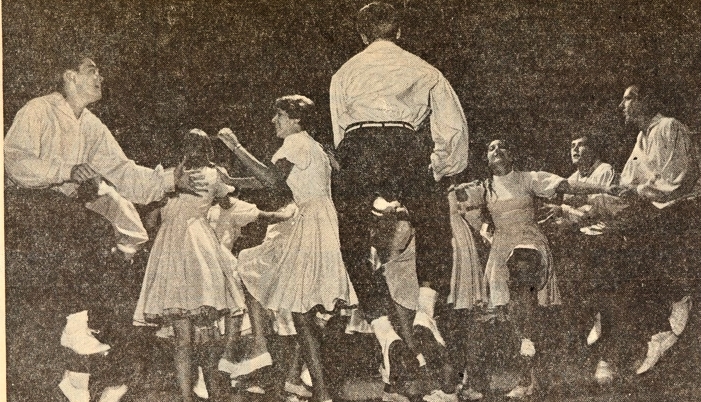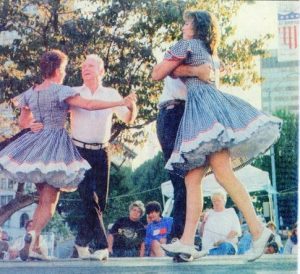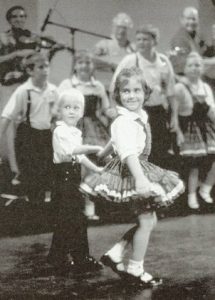While the Mountain Dance and Folk Festival is primarily about music, dance plays an important role as well. Like the music of the mountains, square dancing and clogging has been passed down and can be traced back to Europe. In most forms of square dancing, the dancers are prompted through a sequence of steps by a caller to the beat or the phrasing of music. In clogging the dancers strike the heel of their feet, or the toe, or both against the floor or each other to create audible rhythms, usually to the beat with their heel keeping the rhythm. Team clogging interestingly enough originated from square dance teams in the Mountain Dance and Folk Festival. (2)
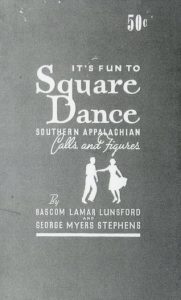
This pamphlet was created in 1966 by Bascom Lamar Lunsford and George Myers Stephens to teach people how to square dance. (3)
Mountain dance is a living thing. Through the years steps and moves are added creating new and exciting dances to be shared at events such as the Mountain Dance and Folk festival. Music plays an intricate roll in team dancing in the Mountains. The most popular musical instruments are the guitar, the violin and the five-string banjo. When Square Dancing it is important to watch the caller (the person calling out the dance figures and steps for the participants) so as not to miss cues. This is important in this kind of group dancing. Square dancing can be quiet graceful if every player is moving together and on time with the music. (4)
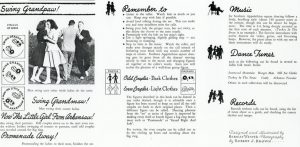
This page from the “Its Fun to Square Dance” pamphlet gives tips and a little bit of info on what kind of music typically goes with Square Dancing. (5)
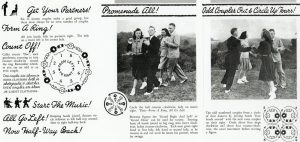
These images from the “Its Fun to Square Dance” pamphlet show the beginning moves of a typical Square Dance. (6)
Clogging goes hand in hand with Appalachian music. The music of Appalachia has been passed down from England, Scotland and Ireland. Many of the Mountain tunes played today originate from these areas fiddle tunes. Clogging has even broader roots. Much of its origins not only come from the United Kingdom and Scotland, but also Germany, Africa and the Cherokee nation to name a few. Clogging is a form of expression that times itself to the music and adds even more rhythm to the already vibrant Appalachian compositions. (7)
References
1: Asheville Citizen Times, 1998, Box 6, Folder 68, Mountain Dance and Folk Festival, D. H. Ramsey Library Special Collections, University of North Carolina at Asheville, Asheville, NC.
2: Larry W. Mull, “Everybody Square Dances! In the Southern Appalachians,” 1948, Box 6, Folder 4, Mountain Dance and Folk Festival, D. H. Ramsey Library Special Collections, University of North Carolina at Asheville, Asheville, NC.
3: Bascom Lamar Lunsford and George Myers Stephens, “Its Fun to Square Dance, Southern Appalachian Calls and Figures,” 1966, Box 6, Folder 6, Mountain Dance and Folk Festival, D. H. Ramsey Library Special Collections, University of North Carolina at Asheville, Asheville, NC.
4: Bascom Lamar Lunsford and George Myers Stephens, “Its Fun to Square Dance, Southern Appalachian Calls and Figures.”
5: Bascom Lamar Lunsford and George Myers Stephens, “Its Fun to Square Dance, Southern Appalachian Calls and Figures.”
6: Bascom Lamar Lunsford and George Myers Stephens, “Its Fun to Square Dance, Southern Appalachian Calls and Figures.”
7: Larry W. Mull, “Everybody Square Dances! In the Southern Appalachians.”
8: Unidentified dancers, “Along About Sundown…1928-2002,” 2002, Box 6, Folder 15, Mountain Dance and Folk Festival, D. H. Ramsey Library Special Collections, University of North Carolina at Asheville, Asheville, NC.
Header Image: Asheville Citizen Times, 1970, Box 6, Folder 40, Mountain Dance and Folk Festival, D. H. Ramsey Library Special Collections, University of North Carolina at Asheville, Asheville, NC.
